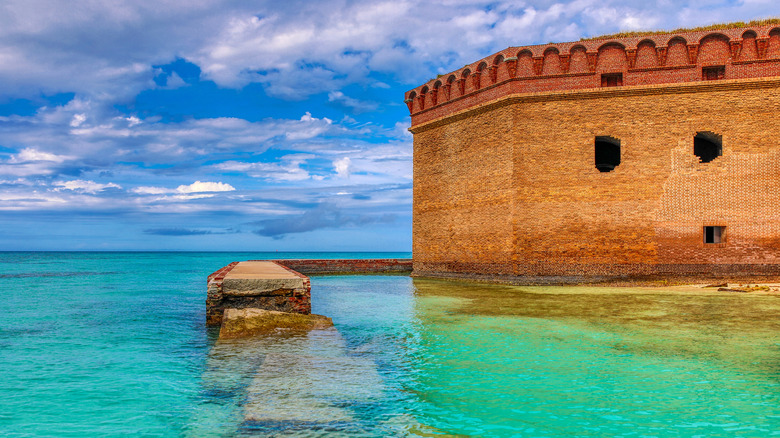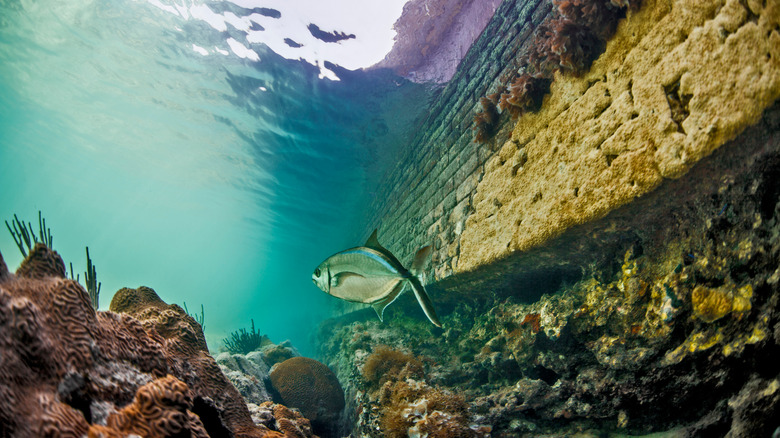Explore This Off-The-Grid Florida National Park That's 99% Underwater
It may not come as a surprise that Florida, the most visited state in the U.S., is home to one of the country's most amazing marine national parks. What may be a bit more unexpected, is that this national park is also one of the most remote. But, situated in the Gulf of Mexico some 70 miles west of Key West, the Dry Tortugas National Park is both of those things. Given that it also offers several national park activities you might not know about, it is easy to see why Dry Tortugas National Park should be included on everyone's national park bucket list.
However, the elements that make visiting the Dry Tortugas National Park such a unique experience, also make it a little more challenging to reach. For starters, the park can only be reached by boat or plane. Once you arrive on Garden Key, where the park headquarters are located, you will need a kayak, canoe, boat, or seaplane to reach the other six islands that comprise the park. The good news is you don't necessarily have to have your own boat or plane. The Yankee Freedom Ferry runs regular passenger service to and from the Dry Tortugas National Park. Visitors are able to bring up to 60 pounds of gear (including kayaks), but an advance ticket purchase is necessary. Key West Seaplane Adventures offers a similar service via air. Those who do arrive aboard their own vessels must check in at the park headquarters and pay the required fees.
Water-based activities at Dry Tortugas National Park
Given that less than one percent of the Dry Tortugas National Park is comprised of land, it is only natural that a good deal of the recreational activities there take place in the water. Swimming and snorkeling rank right near the top of popular water-based activities at the park. There are designated swimming areas on both Garden Key and Loggerhead Key, but visitors should be advised there are no lifeguards at these areas nor on any of the other beaches or islands within the park's boundaries.
There are numerous popular snorkeling spots located throughout the park, including the Fort Jefferson Moat Wall and Texas Coral Reef on Garden Key, as well as Little Africa Coral Reef on Loggerhead Key. Diving is also popular at these spots, as well as sites such as the Windjammer Shipwreck. However, the passenger ferry and seaplane are unable to bring compressed air tanks, so anyone wanting to scuba must arrive on their own boat or charter boat.
Those who do travel to the Dry Tortugas National Park aboard their own boat can also spend time hopping between the park's seven islands. Private boaters need to be well supplied, though, as there are no supplies, freshwater, or fuel at the park. Those who come aboard the ferry can bring along a kayak to explore the various islands within the park as well. Fishing is yet one more option for boaters and kayakers.
Land-based activities at Dry Tortugas National Park
Although only one percent of the Dry Tortugas National Park is dry land, there is plenty of land-based adventure to be had on the seven sandy islands that make up the park. The most popular thing to do ashore is exploring Fort Jefferson, the largest brick fort in the United States. Construction on this fort began in 1846. By the time constructions ceased in 1874, this octagonal fortress covered almost the entirety of Garden Key. The Garden Key Light is even older than the fort, having been established as a lighthouse in 1824.
Another lighthouse is located on Loggerhead Key and is also a popular spot to visit in the Dry Tortugas National Park. Loggerhead Key itself, the largest of the islands within the park, is a great place to explore. Depending on the conditions, there are at times an exposed land bridge between Loggerhead Key and Garden Key. At other times, a kayak or boat is necessary to travel between the two.
Birding and wildlife viewing are other activities those exploring the islands can enjoy. Shore fishing is also available from numerous locations within the park. Finally, although day visits to Dry Tortugas National Park are common, with so many things to do, you may not want to come back after just one day. Fortunately, camping is allowed within the park. An overnight camping fee is required and campers must bring all necessary supplies, as none are available at the park.


